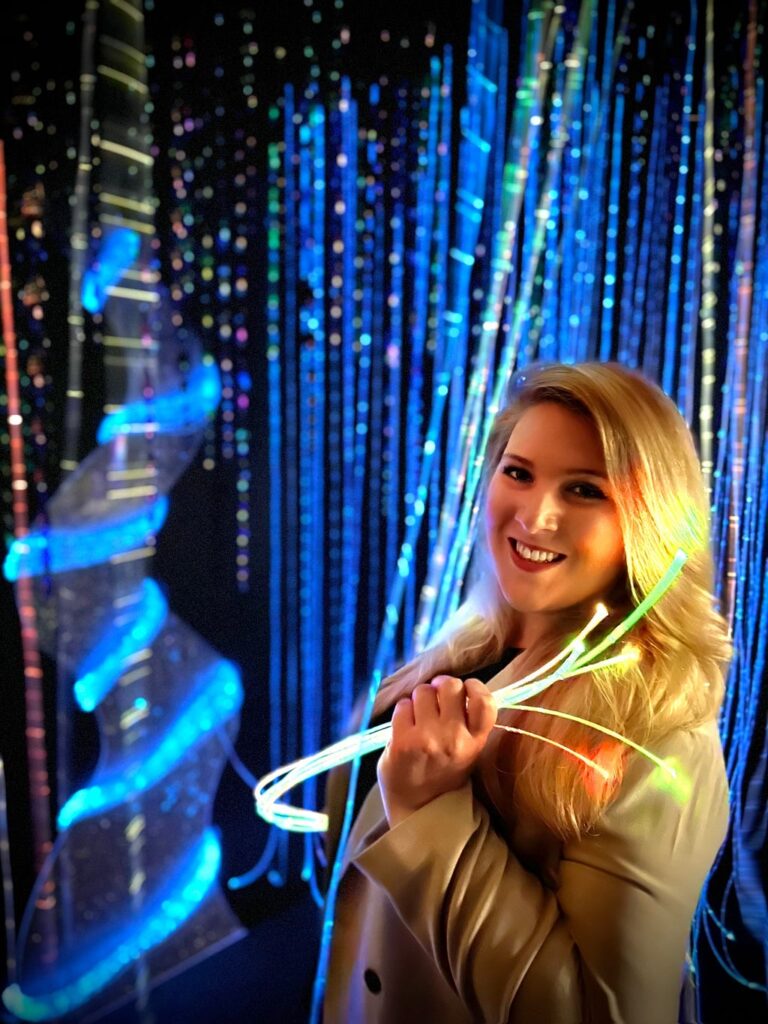Dr Bliss Cavanagh Of Creative Sensory Spaces On How To Design Office Spaces That People Love To Work In
An Interview With Ben Ari
Not sure where to start or want to be a leader to workplace wellbeing? There are a number of amazing businesses out there that specialise in assessing and designing unique solutions for workplace happiness, culture, design and productivity.
As a part of our series called “How To Design Office Spaces That People Love To Work In”, we had the pleasure of interviewing Dr. Bliss Cavanagh.
Dr Bliss Cavanagh is both an artist and an academic who challenges the ways our traditional built environment influences our experience of life. Dr Cavanagh is founder and owner of Creative Sensory Spaces, who design and install calming sensory rooms.
Bliss’s PhD research investigated the health and wellbeing benefits of her innovative multisensory environments. It drew on the science and benefits of positive psychology, receptive arts engagement, restorative environments and multisensory interventions. Published internationally, it proved the benefits of sensory spaces in the general population.
Since gaining her PhD, Bliss has worked on many major commissioned projects within mental health, disability, education, gallery and community settings to engage and resolve issues of accessibility, inclusivity, mental health and wellness.
Thank you so much for joining us in this series! Before we dive in, Our readers would love to learn a bit more about you. Can you tell us a story about what brought you to this specific career path?
Creative Sensory Spaces was born from a personal journey. I was always very shy growing up, but I found so much joy in being creative. My art making became a strong part of my identity and when I was diagnosed with Tourette syndrome at age 9, it then became my most valuable outlet.
It was during my Bachelor of Fine Art Honours year at The University of Newcastle when I discovered my purpose. My artmaking became more abstract, playing with colour, light and texture, focusing on the experience of space. Through research I discovered the remarkable benefits of sensory rooms, which at the time, were only used as a therapeutic tool in certain clinical populations and weren’t accessible to the public or even well-known. I realised that this is what I had been doing my whole life, collecting and surrounding myself with mood lamps in the dark, listening to music and burning scented candles; creating a sensory experience to help me feel relaxed and self-manage my symptoms. All these connections led me to create my own personal multisensory environment for my major project, which completely transformed my life. Until this, I had kept my diagnosis of Tourette’s hidden from fear of being stigmatised. This had impacted my mental health significantly and the anxiety affected many aspects of my life. But I had always found comfort in creativity.
Immersed in the space, I had never felt so relaxed and tic-free before. I was empowered to share my experience of living with Tourette syndrome through my art in such a positive way. The unexpected outcome was the response from others who experienced the space and who shared similarly remarkable benefits. I saw that I had the potential to help others and this gave me such a profound sense of purpose and clarity in the vision for what I wanted to see in the world and how the external world around us can better support our internal needs.
I began to take on large-scale commissions to create sensory spaces for events and develop my signature calming sensory space designs, establishing my business Creative Sensory Spaces. I fundamentally believed in the benefits and value I was seeing that these spaces had, not just for people with neurodiversity, but for the population as a whole. We all need more calm in our lives. We all feel stressed at times. We all need room to reset. Completing a PhD investigating the benefits of sensory spaces in the general population was the clear next step towards my vision and published internationally, this research was the first to prove the effectiveness of such spaces in our everyday work and living environments. All our spaces are backed by evidence-based research and we bring a unique insight from lived experience to the design and delivery or every room we create for businesses, schools, venues and organisations.
It has been said that sometimes our mistakes can be our greatest teachers. Can you share a story about a mistake you made when you were first starting and a lesson you learned from that?
Starting out we were determined to say yes to everything. Consequently, resources were stretched to capacity, energies were depleted, and the vision became a little more difficult to articulate. The greatest lesson I learnt was to ‘create your niche’, which for us was specialising in the design and delivery of ‘calming’ sensory spaces. Identifying clearly what we didn’t do became just as important as what we do offer. Once I leaned into the core findings of my PhD research and the true value of our signature calming sensory spaces, we were able to distinguish Creative Sensory Spaces as the leaders in the field of sensory rooms purpose-designed for calming benefits, and more importantly, amplify our reach and the outcomes we work to achieve.
What are some of the most interesting or exciting projects you are working on now? How do you think that might help people?
Excitingly, we are working on developing calming sensory spaces for two major stadiums — stay tuned for details soon! The primary purpose of these dedicated spaces is to improve inclusion and increase attendance of neurodiverse patrons by providing a dedicated space for anyone who many need room to reset. Event attendees who may experience a sense of overwhelm, anxiety or sensory overload can take 10–15 minutes to take time-out, reset and re-enter the sporting match or concert. We have been working with the event staff who have already shared the successes of patrons who would have left the event otherwise, were able to stay and enjoy the experience.
You are a person of great influence. If you could start a movement that would bring the most amount of good to the most amount of people, what would that be? You never know what your idea can trigger. 🙂
The Universal Sensory Movement — our senses are what shapes our experience of life and are the most universal element that connects us as human beings. We can use multisensory experiences to connect with ourselves and others in a way that truly promotes inclusion and empowers our ability to better support our mental health and wellbeing.
We are very blessed that some of the biggest names in Business, VC funding, Sports, and Entertainment read this column. Is there a person in the world, or in the US whom you would love to have a private breakfast or lunch with, and why? He or she might see this, especially if we tag them 🙂
Nicola Forrest — a powerhouse woman who is passionate about inclusion and supporting children and young people in new and innovative ways. Our work installing calming sensory spaces into mainstream schools to promote inclusion and provide better ways to assist students to self-regulate their own emotions is a large part of our vision for a better future.

What are your “Five Things You Should Do To Design Office Spaces That People Love To Work In” and why?
1 . Design with purpose:
Consider what qualities your staff need to succeed and work backwards from there. This will vary significantly depending on your industry but could include: a calm, capable and friendly manner with clients, excellent organisational skills, attention to detail, creativity, or ingenuity. Gaining a clear understanding of the outcomes you wish to foster within your office environment will greatly impact your ability to create or alter the environment in a way that best supports your people and culture. For example, unresolved stress will inhibit each of those things listed above therefore helping staff to unwind could be one of the best things you can do to improve performance.
2 . Re-evaluate space
Do you have any dis-used meeting rooms that have become storage facilities, or perhaps interesting nooks that could be re-purposed or transformed to better support your staff? Finding a space that you can transform into a dedicated calming space communicates clearly to your employees that you value and support their mental health. This can empower staff to self-manage their own stress, take a short break to reset or unwind and enable them to re-enter the workplace at optimal capacity.
3 . Incorporate nature and art:
More broadly, the design of office spaces as a whole, can be more supportive. Extensive research tells us that incorporating artworks, plant life and views of nature into workspaces and buildings promotes ‘positive distraction’. Positive distraction is an effect that results in cognitive restoration and emotional rejuvenation, reduced levels of stress and anxiety and supports overall wellbeing. In particular, artworks that incorporate nature-based imagery, and the incorporation of nature, speaks to our innate tendency as human beings to seek connections with nature, known as the Biophilia hypothesis.
4 . Options and choices:
Every individual has their own sensory preferences. The way we process sensory input can greatly influence how we adapt and respond to our environment, as well as shaping our emotions, mood and behaviours. Understanding your sensory preferences is an essential tool to better create external environments that can support your productivity, motivation and mood levels. This can empower us to proactively control and enhance our ability to perform at our optimal capacity. Ideally we should consider having options and choices for staff to alter their workspace according to their individual needs. Opt for dimmable lighting where possible, provide access to window views or more private nooks within the open plan space. Create a dynamic working environment that allows people to seek out the environmental input they need to achieve the tasks they are working on. Many people are more sensitive to fluorescent lighting, background noises or chatter, untidiness or even desk positioning. Fostering an environment that encourages individuals to find their ‘just right’ feeling is key to boosting productivity and wellbeing.
5 . Bring in an expert:
Not sure where to start or want to be a leader to workplace wellbeing? There are a number of amazing businesses out there that specialise in assessing and designing unique solutions for workplace happiness, culture, design and productivity.
At Creative Sensory Spaces, we design, create and install world-leading sensory spaces with long-lasting calming benefits. Our bold, otherworldly yet harmonious nature-inspired themes promote mental and emotional refreshment by engaging the senses. Reach out to us to design a dedicated calming sensory space to refresh your workforce and improve productivity.
Thank you so much for joining us. This was very inspirational!
Dr Bliss Cavanagh Of Creative Sensory Spaces On How To Design Office Spaces That People Love To… was originally published in Authority Magazine on Medium, where people are continuing the conversation by highlighting and responding to this story.
